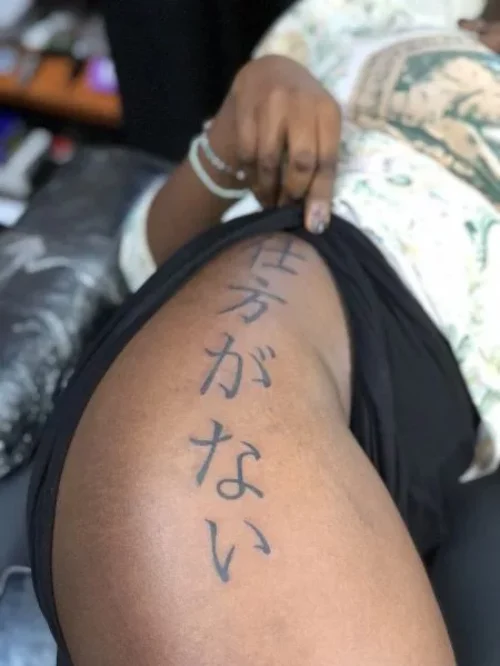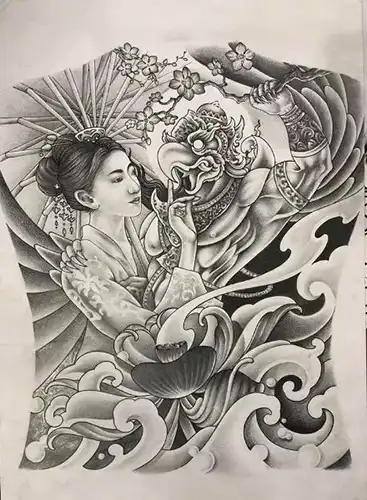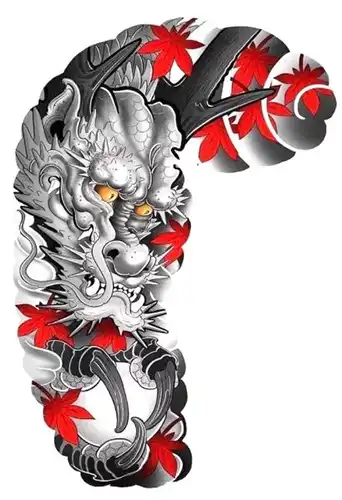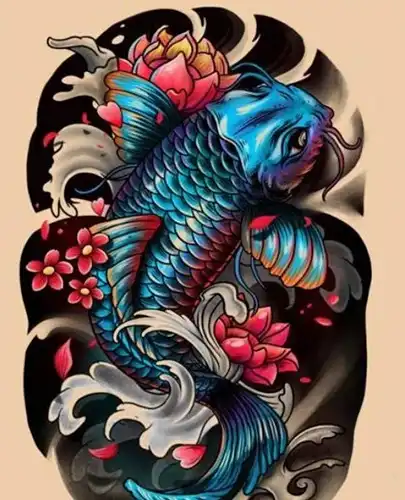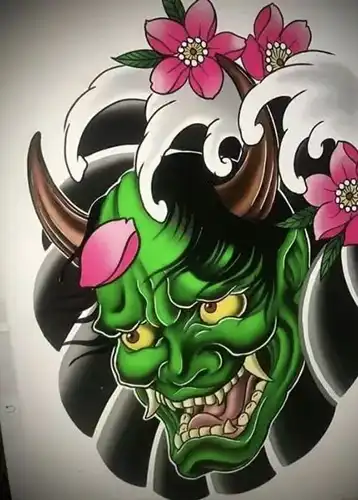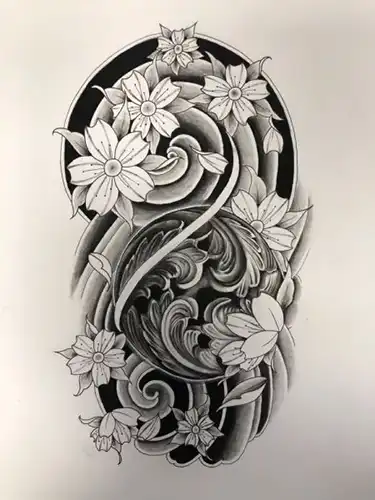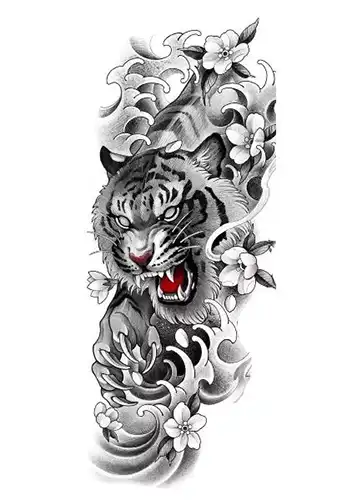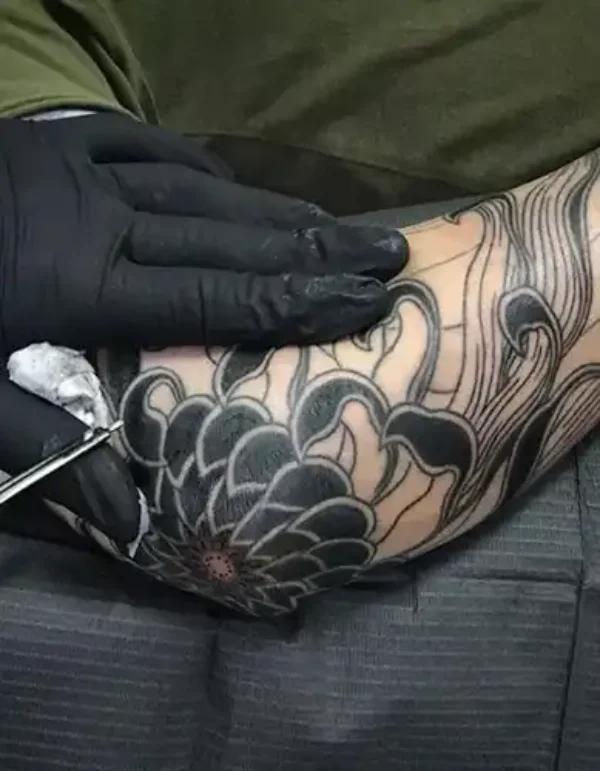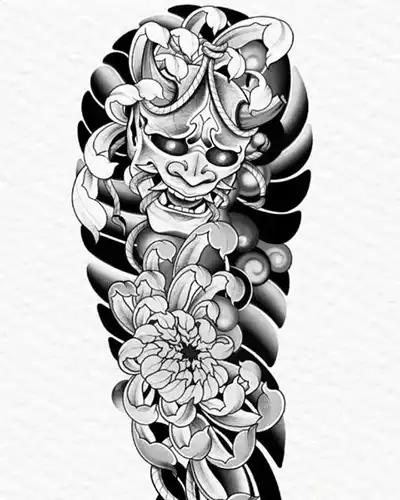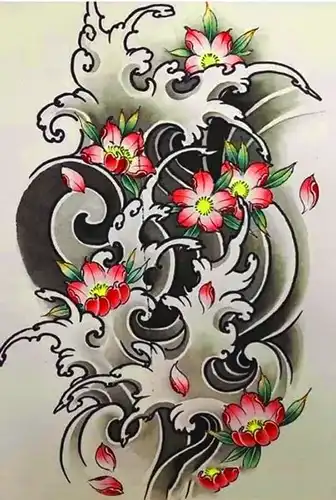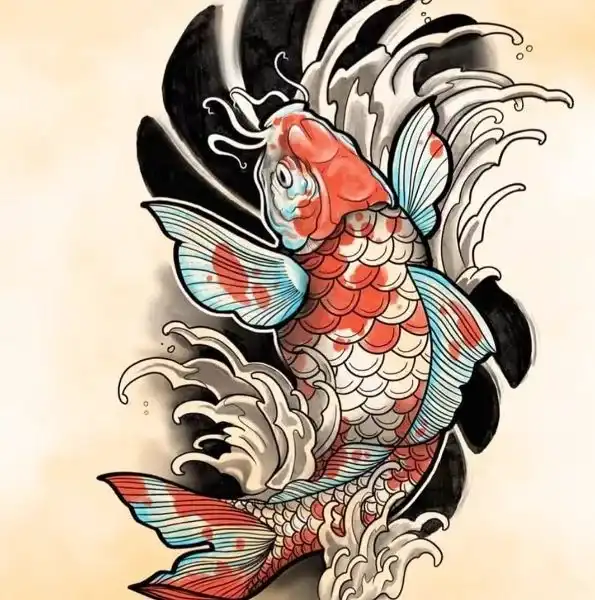Japanese Tattoos in Nairobi, Kenya
Japanese tattoos, also known as Irezumi, have a rich history and cultural significance in Japan. Traditional Japanese tattooing is characterized by its distinct artistic style, featuring vibrant colors, intricate designs, and a combination of various elements such as mythological creatures, flowers, waves, and traditional Japanese motifs.
Japanese Tattoos
Traditionally, these tattoos were associated with the yakuza, the Japanese organized crime syndicates. They served as symbols of status, loyalty, and dedication within the criminal underworld. However, in recent years, Japanese tattoos have become more mainstream and appreciated as a form of art globally.
The process of creating a traditional Japanese tattoo is time-consuming and often requires multiple sessions, as the designs are complex and cover large areas of the body. Skilled tattoo artists, called horishi, use handheld needles to meticulously hand-poke or use modern tattoo machines to create the desired design.
The themes and symbols found in Japanese tattoos often carry significant meanings. For example, dragons represent strength and wisdom, koi fish symbolize perseverance and transformation, cherry blossoms represent the transience of life, and samurai warriors embody honor and bravery.
It’s important to note that getting a Japanese tattoo or any tattoo is a personal decision, and it’s essential to research and find a skilled and reputable tattoo artist who specializes in Japanese tattooing. They will be able to discuss the design, placement, and significance of the tattoo, ensuring that it aligns with your preferences and respects the cultural heritage associated with Japanese tattoos.
If you’re considering getting a Japanese tattoo or have further questions about the subject, contact us(Rebel Inks Tattoo Kenya) and to get the much needed expertise and professional advice on a specific style.
Japanese Tattoos Design Techniques
Japanese tattoos are known for their unique design techniques that have been developed and refined over centuries. Here are some notable design techniques commonly seen in Japanese tattoos:
Full-body Coverage
Traditional Japanese tattoos often cover large areas of the body, such as the back, chest, or full sleeves. This allows for the creation of cohesive and elaborate designs that flow harmoniously across different body parts.
Irezumi Style
The term “Irezumi” refers specifically to the traditional Japanese tattooing style. It emphasizes bold outlines, vibrant colors, and intricate details. The use of shading techniques, such as hatching (parallel lines) and gradation, adds depth and dimension to the designs.
Symbolic Motifs
Japanese tattoos incorporate a wide range of symbolic motifs deeply rooted in Japanese culture and folklore. These motifs include dragons, koi fish, cherry blossoms, peonies, lotus flowers, geisha, samurai, phoenixes, tigers, waves, and more. Each motif carries specific meanings and associations.
Horimono Technique
Horimono refers to the act of carving or engraving the skin with a tattoo. Traditional Japanese tattoos often utilize the horimono technique, which involves hand-poking the design into the skin using a set of handheld needles. This technique allows for precise control and detailed line work.
Background and Filling Techniques
Japanese tattoos commonly feature dynamic and elaborate backgrounds to complement the main subject. Techniques like namakubi (clouds), waves, wind bars, or water designs are often used to fill the negative spaces, adding movement and energy to the overall composition.
Color Palette
Traditional Japanese tattoos make use of a vibrant color palette. Colors like red, yellow, blue, green, and purple are often employed to create visually striking designs. These colors are carefully selected to evoke specific emotions and convey the desired symbolic meanings.
When considering a Japanese tattoo design, it’s essential to work closely with a skilled tattoo artist who specializes in this style. They will have a deep understanding of the techniques and symbolism associated with Japanese tattoos and can help create a design that reflects your vision while staying true to the traditional elements of the art form.
Schedule Appointment
Japanese Tattoo Placement
Traditional Japanese tattoos are often designed to cover large areas of the body, with specific placements chosen to enhance the overall aesthetic and symbolic meaning of the design. Here are some common placements for Japanese tattoos:
- Full Back (Irezumi): The full back is one of the most popular placements for Japanese tattoos. It provides a vast canvas for elaborate and visually stunning designs such as dragons, tigers, samurai, or mythological scenes. The back allows for the incorporation of various elements and motifs that can be connected seamlessly across the entire area.
- Full Sleeve (Horimono): A full sleeve tattoo extends from the shoulder to the wrist, covering the arm with a cohesive design. Traditional Japanese sleeve tattoos often feature themes like koi fish, dragons, peonies, or waves. The sleeve allows for a narrative or thematic composition, with different elements flowing together harmoniously.
- Half Sleeve: A half sleeve tattoo covers either the upper arm or lower arm, typically from the shoulder to the elbow or from the elbow to the wrist. The placement offers ample space for intricate designs while providing the option to showcase or conceal the tattoo as desired. Common motifs include cherry blossoms, geisha, or traditional Japanese masks.
- Chest and Front: The chest and front of the body can be adorned with Japanese tattoos, creating a powerful and impactful display. Designs may include large-scale images like dragons, phoenixes, or traditional Japanese motifs like wind bars (kamon) or cherry blossoms. These placements are often chosen to symbolize strength, courage, and protection.
- Thigh: Thigh tattoos offer a sizable area for Japanese designs, particularly for larger motifs like dragons, tigers, or traditional Japanese folklore characters. The curvatures of the thigh can be utilized to create dynamic and visually engaging compositions.
- Calf: Japanese tattoos on the calf can feature designs such as waves, koi fish, or cherry blossoms. The elongated shape of the calf allows for the incorporation of vertical elements that complement the natural form of the leg.
These are just a few examples of common placements for Japanese tattoos. However, it’s important to remember that tattoo placement is a personal choice, Contact Us Today to determine the best placement based on the design, your body shape, and your preferences. At Rebel Inks Tattoo Kenya we provide guidance on how the design will interact with different body areas and help create a tattoo that fits harmoniously with your body.
Japanese Tattoo Colors
Japanese tattoos traditionally incorporate a specific color palette that plays a significant role in their overall aesthetic and symbolism. Here are some of the colors commonly used in Japanese tattoos:
- Red (Akane or Beni): Red is a dominant color in Japanese tattoos and holds great symbolic importance. It represents life force, energy, passion, and vitality. Red is often used for elements like dragons, koi fish, cherry blossoms, and flames.
- Black (Kuro): Black is another prominent color in Japanese tattoos. It is used for bold outlines and shading to create contrast and define the shapes and contours of the design. Black ink is essential for creating depth and adding dramatic impact to the overall composition.
- Blue (Ai): Blue is often associated with water in Japanese tattoos. It represents tranquility, calmness, and fluidity. Blue is commonly used for waves, rivers, waterfalls, and other water-related elements in Japanese tattoo designs.
- Yellow (Ki): Yellow symbolizes brightness, joy, and positivity in Japanese culture. It is often used for elements like sun rays, highlights, and certain flowers to add vibrancy and visual interest to the design.
- Green (Midori): Green represents nature, growth, and renewal. It is frequently used for foliage, leaves, and trees in Japanese tattoo designs. Different shades of green are employed to create depth and realism in natural elements.
- Purple (Murasaki): Purple is a less commonly used color in Japanese tattoos but can be found in certain designs. It symbolizes spirituality, nobility, and mystery. Purple may be used sparingly to enhance certain elements or add a touch of elegance to the overall composition.
It’s important to note that while these colors are traditionally associated with Japanese tattoos, contemporary tattoo artists may incorporate a wider range of colors or experiment with variations based on their artistic vision and the preferences of the individual getting the tattoo.
When considering a Japanese tattoo design, discuss color choices and their symbolic Contact Us Today to ensure the design aligns with your intentions and reflects the traditional elements of Japanese tattooing.
Factors that you should consider when getting a Japanese tattoo
When getting a Japanese tattoo, there are several factors you should consider to ensure a successful and meaningful experience. Here are some key factors to keep in mind:
- Research and Understanding: Take the time to research and familiarize yourself with Japanese tattoo art, its history, cultural significance, and symbolism. Understanding the meaning behind different motifs and elements will help you choose a design that resonates with you personally.
- Style and Design: Japanese tattoos encompass a wide range of styles and motifs. Consider the specific style you prefer, such as traditional Irezumi, contemporary interpretations, or a fusion of styles. Explore different design options and consult with a skilled tattoo artist who specializes in Japanese tattoos to develop a unique design that suits your vision.
-
Placement: Think about where you want the tattoo to be placed on your body. Consider factors like visibility, size, and the suitability of the design for the chosen area. Certain designs may work better on specific body parts, so consult with your tattoo artist for their input on placement options.
-
Size and Scale: Japanese tattoos often feature large-scale designs that cover significant portions of the body. Consider the size and scale of the tattoo you desire. Larger designs may require multiple sessions and a higher level of commitment, so be prepared for the time and dedication it may require.
- Skilled Tattoo Artist: Choose a highly skilled and experienced tattoo artist who specializes in Japanese tattooing. Look at their portfolio to assess their proficiency in this specific style. Ensure that the artist understands the symbolism, techniques, and cultural nuances associated with Japanese tattoos.
- Communication and Collaboration: Establish clear communication with your tattoo artist. Share your ideas, inspirations, and preferences while remaining open to their suggestions and expertise. A collaborative approach will result in a design that is tailored to your vision while incorporating the artistic skills of the tattoo artist.
- Commitment and Patience: Japanese tattoos are often intricate and time-consuming to complete. Understand that the process may require multiple sessions, spaced weeks or months apart, depending on the size and complexity of the design. Be patient and committed to the process to achieve the desired outcome.
- Cultural Respect: Japanese tattoos have a deep cultural and historical significance. Show respect for the culture by choosing designs and elements that are authentic and meaningful. Avoid appropriating or misrepresenting cultural symbols or practices.
Remember, getting a tattoo is a personal decision, and it’s important to take the time to consider these factors to ensure that your Japanese tattoo is a reflection of your personal style, values, and cultural appreciation.
Cost of Japanese Tattoos in Nairobi, Kenya
The cost of Japanese tattoos, or Irezumi, can vary widely depending on several factors such as size, complexity, color, the artist’s experience, and the location of the tattoo studio. Here’s a detailed breakdown of what you might expect to pay:
Factors Influencing Cost
- Size: Larger tattoos require more time and materials, thus costing more.
- Complexity: Intricate designs with detailed patterns and shading will typically be more expensive.
- Color vs. Black and Grey: Color tattoos may cost more due to the additional time and materials required for coloring.
- Artist’s Skill and Experience: Renowned and highly skilled artists will charge more for their expertise. At Rebel Inks Tattoos, Tattoo Removal, and Body Piercings Parlour we have experienced artists who offer quality and premium services.
- Location of the Studio: Tattoo studios in major cities or areas with a high cost of living generally charge more. Rebel Inks Tattoos, Tattoo Removal, and Body Piercings Parlour is located in the heart of the Central Business Disrict (CBD) in Nairobi, Kenya, and is easily accessible to both locals and foreigners in the country
- Placement on the Body: Certain body areas that are more challenging to tattoo may affect the price.
General Pricing Guidelines
- Small Japanese Tattoo (1-2 hours): Ksh. 3,000 – Ksh. 5,000
- Medium Japanese Tattoo (2-5 hours): Ksh. 8,000 – Ksh. 10,000
- Large Japanese Tattoo (5+ hours, multiple sessions): Ksh. 20,000 or more
Example Costs for Specific Pieces
- Half Sleeve (Upper Arm, 10-15 hours): Ksh. 30,000 – Ksh. 40,000
- Full Sleeve (20-40 hours): Ksh. 60,000- Ksh. 80,000
- Backpiece (40-60 hours): Ksh. 100,000 – Ksh. 200,000
- Full Body Suit (100+ hours): Ksh. 500,000- Ksh. 1,000,000 or more
Additional Costs
- Consultation Fee: At Rebel Inks Tattoos, Tattoo Removal, and Body Piercings Parlour we might charge a fee for the initial consultation, which may be applied toward the final cost of the tattoo.
- Touch-Ups: After the tattoo heals, touch-ups may be necessary to ensure the design looks its best. Some of our artists include touch-ups in the initial price, while others charge separately.
- Deposit: At Rebel Inks Tattoos, Tattoo Removal, and Body Piercings Parlour we will require a deposit to book an appointment, which is usually deducted from the total cost of the tattoo.
Tips for Budgeting
- Consultation: Schedule consultations with a few artists to discuss your design and get quotes.
- Save Up: Consider saving up for a high-quality tattoo rather than opting for a cheaper, less experienced artist.
- Plan for Multiple Sessions: If you’re getting a large or complex piece, be prepared for multiple sessions and budget accordingly.
Choosing an Artist
- Experience: Opt for an artist with experience in Japanese tattoos to ensure they can execute the style you want. At Rebel Inks Tattoos, Tattoo Removal, and Body Piercings Parlour we have experienced artists who offer quality and premium services.
- Portfolio: Review the artist’s portfolio to see their previous work and make sure their style aligns with your vision. At Rebel Inks Tattoos, Tattoo Removal, and Body Piercings Parlour we have an extensive portfolio of black and gray tattoo designs.
- Reputation: Look for reviews and recommendations to find a reputable artist.
By considering these factors and planning accordingly, you can better understand the costs involved in getting a Japanese tattoo and ensure you choose an artist who can bring your vision to life.
Get In Touch
For more information on the list above and any other special services,please call or come in for free consultation
Testimonials
After he pierced my industrial piercing and seeing his amazing work, I feel even more excited about getting my tattoo with him in January. I’m really looking forward to it!
I am extremely happy with my new 'Safari' tattoo from Eric at Rebel Inks! The quality of the artwork is fantastic. Eric is a true professional and an amazing artist.
The preparation and design process was thorough and collaborative. He was very patient with my specific requests, including making sure all the elements, which hold personal meaning, were perfect.
The service was friendly and highly professional from start to finish. Despite the 8-hour session, Eric was a pleasant person to spend the time with.
The aftercare guidance and follow-up have been excellent and careful, which has made the healing process easy and better than expected.
I highly recommend Eric for anyone looking for a thoughtful, talented, and caring tattoo artist.
I recommend them 💯
I would definitely recommend if you’re thinking of getting a piercing!
The staff were super friendly, explained everything clearly, and made me feel so at ease. They answered all my nervous questions (and I had many questions),
They walked me through the whole process, gave detailed aftercare instructions, and even followed up afterward to check how I was healing 🫶
Clean, professional, and full of good vibes.
Would 100% recommend . Definitely making a second trip here.
This was the second tattoo I got and I wish I could have come to Eric for my first one! He gave me really great after-care directions for the tattoo as well as a little jar of his own Vaseline-type stuff to put over my tattoo while it was healing! He even put second skin over my tattoo so that I didn’t have to worry about it for the first few days. Now THAT’S good service. My first tattoo artist didn’t do none of that lol.
After the session Eric didn’t rush me and my friend out, he chatted with us and even when he found out I was an artist too— really encouraged me to keep creating and to find a community of artists to support me. I almost cried because I’ve had such a hard time with my own art the past couple of years, it meant so much to me to have a fellow very talented artist say that to me. 🤍🤍🤍
Eric you’re amazing, don’t ever stop creating and just know you’ve impacted lives all over the world!🫶🏻 thanks so much for everything!!
From the moment I walked in, Eric was professional, welcoming, and attentive. He made sure I was comfortable throughout, provided everything I needed, and explained every step of the process. The tattooing itself was unbelievably smooth - I genuinely felt no pain compared to my previous tattoos over the last 22 years.
Eric also gave me excellent aftercare guidance and products, and thanks to that, my tattoo healed beautifully. The attention to detail, precision, and shading are absolutely stunning. This is hands-down the best tattoo I've ever had, and I will be flying back to Nairobi for any future ink.
If you want incredible art, a professional experience, and a talented artist who truly cares about his clients, Rebel Ink is the place to go!
From start to finish, the service was exceptional. The piercer was professional, knowledgeable, and made me feel completely comfortable. The cleanliness of the place was above and beyond — everything was spotless and hygienic, which really put me at ease. Highly recommend for anyone considering a piercing!
Shout out to Eric😘
We ended up changing the jewelry three times to ensure I had the best fit and avoided any signs of rejection, and he always listened to my suggestions as a client, which I really appreciated. Now, three months in, my piercing is healing beautifully, with no sign of rejection. Highly recommend for anyone who values a piercer who cares about your comfort and healing journey!
What stood out the most was the aftercare Eric checked in with me even three weeks later to see how the tattoo was healing. That kind of follow-up shows how much he truly cares about his work and his clients.
I’m very satisfied and will definitely be coming back for my next piece. Highly recommend!
The piercing wasn't as painful as I had thought and the process was quick and satisfactory. I love it!!!
The piercing is healing well thanks to the aftercare instructions and follow-up. I would highly recommend Rebel Inks
Eric also did a belly button piercing for a friend, guiding her through the process, doing the piercing and then explaining the after care to her.
The shop is on the 3rd floor, with the entrance to the stairs near an alleyway on the left. The shop is perfect size, clean, and attractive looking. The mural is pretty dope.
Thank you for the amazing service! 🔥👅✨
I got piercibgs there and the process was really good. My biggest concern was hygiene but that wasn't an issue at all, they use new needles and they sanitize them.
The service itself was also welcoming.
I was informes of everything i needed to know beforehand.
10/10 would recommend!
Eric was so calm and patient with my almost 2 year old lady. It was such a clean and hygienic process. We will definitely be back for our second rounds of piercings and maybe even another tattoo!
They assess the area before any art and advise one accordingly. They also give one post clean up process and also do a check up after the body art projects. Overall, I loved my experience and I’m hooked. 👍
Will definitely come back next time I’m in town 🙂
He listened to what I actually wanted and made sure he could fit in the time before I flew back home.
The shop is clean & private and is easy enough to find.
Eric has even checked in a couple of times since to make sure all is good.
I would totally recommend Eric! I absolutely love my Elephants!
I had a very easy healing period and always follow up from Eric to check on my progress...I would highly recommend if you are a first timer because from my experience all went very well and attention to detail
Thank you for a good job and looking forward to send all my friends your way
And all the best with the new year 2025!
From the moment I walked in, the staff was super friendly and made me feel at ease. The studio had a clean, professional atmosphere, which immediately put me at ease. My piercer was incredibly skilled and explained every step of the process, ensuring I was comfortable the entire time. The piercing was quick and practically painless, and the aftercare instructions were clear and easy to follow. I can tell they really care about the health and safety of their clients.
Overall, a fantastic experience—I highly recommend Rebel Inks and Tattoos for anyone looking to get pierced or tattooed!
They do follow up after their services
Eric's Studio isn’t just a place to get a tattoo—it’s an experience. The combination of professionalism, artistic talent, and a welcoming environment makes it a standout destination for anyone considering a tattoo.
I highly recommend Eric’s Studio to both first-timers and seasoned tattoo enthusiasts. If you’re looking for a high-quality tattoo and an enjoyable experience, this is the place to go.
I would definitely recommend their services again and again
Thank you Rebel Ink
My piercings are healing ❤️🩹 well
I would 💯 recommend
I will definitely come back for more .
Two, all the equipments he used for the piercings were new and/or sterilised.
Three, the parlour itself was very clean and was up to par with the hygiene standards.
Four, Eric provided effective aftercare instructions, making sure I knew exactly how to take care of my new piercings and he kept in touch and continues to do so, to check on the healing progress.
I highly highly highly recommend this place!!!
Would definitely recommend them to friends and go back for other piercings
Not only was the piercing process smooth, but he also provided thorough aftercare instructions, making sure I knew exactly how to take care of my new piercings. What really impressed me was that he keeps in touch to check on how the healing is progressing – a sign of true care for his clients.
The shop maintains a high standard of hygiene, and the atmosphere is welcoming and comfortable, which really added to the positive experience. I highly recommend this place to anyone looking for a professional and caring experience. I’ll definitely be coming back for any future piercings!
My appreciation for the excellent customer service I received. The follow-ups were prompt, and I truly appreciated the gentleness and professionalism throughout. Thank you!"
"Looking for professional eyebrow microshading removal? Look no further!"
The customer care is top tier 👌🏾👌🏾.
Wonderful place to get tattoos and piercings. 💯💯
Eric goes ahead to follow up on his clients progress and gives good advice each time I reach out to him.
I would recommend Reble tattoos anytime.
Good job bro we really appreciate.
Ohh and the price is very fair.
The environment was clean , procedure was sterile and the jewelry used are of the best quality.
He followed up with me during the healing process, he educated me on what I needed to do for my aftercare.
Eric is confident, skilled , experienced and the best piercer. Highly recommend Rebel inks.✨
Definitely recommend!
Great experience.
Eric definitely know what he is doing .
I got exactly what I wanted 2 tiny tats on the same finger .
He was kind and patient throughout the session.
Healing process has been good .
Aftercare services were given and regular checkups on the healing process were done.
I would 💯recommend.
Eric gave me the best reception as it was my first time there,and made me trust him all the way. I appreciate good services.
There services are also affordable not to forget 😊.
He was also invested in the aftercare and would ensure I follow the do's and don'ts in taking care of the tattoo and ensuring proper healing and maximum ink retention.
Would highly recommend Rebel Inks Tattoos.
Rebel Inks Tattoo offer the best,affordable and quality tattoo removal services.If you have unwanted ink,choose Rebel Inks Tattoo,they're the best of the best and the professionalism is a top notch.They ensure you're free from unwanted ink with their Laser Tattoo Removal Technology...
I did a Laser Tattoo Removal with them and i can attest they're the best....
Kudos Eric...
I highly recommend.
It was a generally good experience with good hygiene during the piercing process and has been a smooth healing process.... 10/10
tips. Highly recommend 👍🏽
100% recommendable.
I was particularly impressed with Eric's attention to hygiene. He thoroughly cleaned the room before I entered, sanitized all of the equipment he would be using, and changed gloves between each ear. This level of cleanliness gave me great confidence in his professionalism.
Eric's commitment to customer service did not end on the day of the piercing. He followed up with me regularly throughout the healing process to ensure that I was following the aftercare instructions and that my earlobes were healing properly.
I highly recommend Rebel Inks to anyone in Nairobi who is considering getting a piercing. Eric is a highly skilled and experienced piercer who takes great pride in his work.
So I Check all the boxes below and more:
Customer Care: ✔️
Professionalism : ✔️
Cleanliness ✔️
Price: ✔️
After care service ✔️
Thanks and good job, Eric
The place is neat and clean and the equipments he used were also fine standards. Really appreciate his following up with me on the healing 🤗
I WOULD HIGHLY RECOMMEND THEIR SERVICES to everyone. Actually what you see on their website is EXACTLY what you will get. Keep up the good work Rebel inks Tattoos.
The infection is now gone. I would definitely recommend!
Can recommend this place totally and would go back there anytime!
Thanks!
OUR LOCATION
Areas We Serve
NAIROBI
KIAMBU
KAJIADO
MACHAKOS

